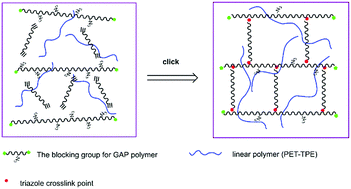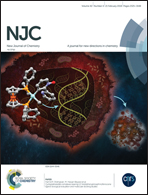Preparation and properties of semi-interpenetrating networks combined by thermoplastic polyurethane and a thermosetting elastomer†
Abstract
A thermosetting elastomer has been introduced into hydroxyl-terminated polyether thermoplastic polyurethane systems by semi-interpenetrating technology. The novel energetic macromolecule materials are investigated by Fourier transform infrared spectroscopy (FTIR), uniaxial tensile test, dynamic mechanical analysis (DMA) and thermal gravimetric analysis (TGA). The results show that this material has good mechanical properties with a stress of 9.7 MPa and strain of 1010.7% when the mass percentage of triazole segments is 20 wt%. It is worth noting that the network structure parameters of semi-interpenetrating materials are quantitatively calculated for the first time based on the relationship between the elastic modulus and the effective crosslinking density. The damping analysis results show that the linear polyurethane domains are tightly embedded into the tridimensional network of triazole domains. In addition, it is confirmed from thermal stability and energy analysis that the samples exhibit good thermal stability and positive heat of formation. Therefore, the novel energetic materials are of potential applied value in the areas of aerospace industry and missile technology.



 Please wait while we load your content...
Please wait while we load your content...